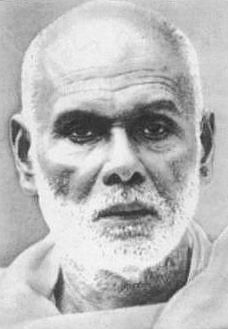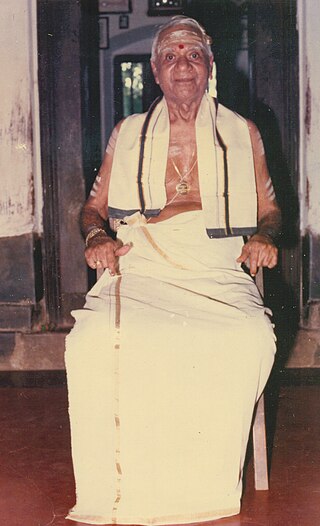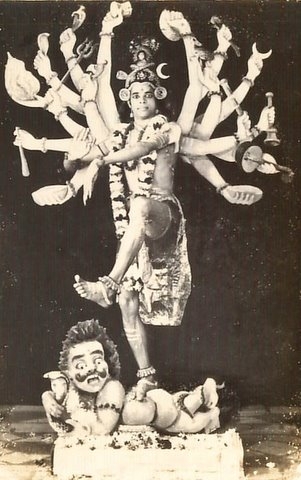
Malayalam, the lingua franca of the Indian state of Kerala and the union territories of Lakshadweep and Puduchery, is one of the six classical languages of India. Malayalam literature comprises those literary texts written in Malayalam, a South-Dravidian language spoken in the Indian state of Kerala. The first travelogue in any Indian language is the Malayalam Varthamanappusthakam, written by Paremmakkal Thoma Kathanar in 1785. Malayalam literature has been presented with 6 Jnanapith awards, the second-most for any Dravidian language and the third-highest for any Indian language.

Sree Narayana Guru was a philosopher, spiritual leader and social reformer in India. He led a reform movement against the injustice in the caste-ridden society of Kerala in order to promote spiritual enlightenment and social equality. A quote of his that defined his movement was "one caste, one religion, and one god for all human beings." He is the author of the Advaita poem Daiva Dasakam, which is one of the most used poem in Kerala for community prayer.
Pillai or Pillay, meaning "Child of King" (Prince) or "Child", is a surname found among the Malayalam and Tamil-speaking people of India and Sri Lanka.

Thunchaththu Ramanujan Ezhuthachan was a Malayalam devotional poet, translator and linguist. He was one of the prāchīna kavithrayam of Malayalam literature, the other two being Kunchan Nambiar and Cherusseri. He has been called the "Father of Modern Malayalam Literature", and the "Primal Poet in Malayalam". He was one of the pioneers of a major shift in Kerala's literary culture. His work is published and read far more than that of any of his contemporaries or predecessors in Kerala.
Perumanoor Gopinathan Pillai, more popularly known as Guru Gopinath was a well known Indian actor-cum-dancer. He is well regarded as the greatest preserver of the dance tradition. He is a recipient of the Sangeet Natak Akademi Award, the Kerala Sangeetha Nataka Akademi Fellowship, and the Kerala Sangeetha Nataka Akademi Award.

Kerala Natanam is a new style of dance that is now recognised as a distinct art form evolved from Kathakali, a form of Indian dance-drama. The Indian dancer Guru Gopinath a well-trained Kathakali artist and his wife Thankamani Gopinath who was the first student of Mohiniyattam in Kerala Kalamandalam developed a unique structure for teaching and performing classical dance forms of India whose origins are from Kathakali. Solo, duets, dance dramas and traditional folk dances were the material they chose.

Vallathol Narayana Menon was a Malayalam poet and one of the triumvirate of modern Malayalam poetry, along with Asan and Ulloor. The honorific Mahakavi was applied to him in 1913 after the publication of his MahakavyaChitrayogam. He was a nationalist poet and wrote a series of poems on various aspects of the Indian freedom movement. He founded the Kerala Kalamandalam and is credited with revitalising the traditional Keralite dance form known as Kathakali.

Tirur is a major municipal town in Tirur Taluk, Malappuram district, in the Indian state of Kerala, spread over an area of 16.55 square kilometres (6.39 sq mi).
Kurup is an Indic surname. Notable people with this surname include:

Guru Mani Madhava Chakyar (15 February 1899 – 14 January 1990) was a celebrated master performance artist and Sanskrit scholar from Kerala, India, considered to be the greatest Chakyar Koothu and Koodiyattam artist and authority of modern times. He was considered as the authority of Abhinaya and Nātyaśāstra.
Eshmanan is a term used in Kerala to refer to a feudal Nair landlord. The term means "lord" in Old Malayalam and referred to Chembazhi nambi or Nambiars, Samanthan Nair and Kiriyathil Nair caste members who occupied the position of rulers and chieftains. Some of the Nambiar landlords, such as Chengazhi Nambiar, Kalliat Eshmanan and Koodali Eshmanan were among the largest landowners in pre-independence Kerala. Other terms for a Nayar feudal landlord, included Nayanar.
Kalamandalam Krishnan Nair was a Kathakali dancer from Kerala in India.

Vayaleri kunhikannan Gurukkal-(Vagbhatananda) was a Hindu religious leader and Reform movement in British India. He was the founder of the Atmavidya Sangham, which was fundamentally a group of professionals and intellectuals who sought change, and also the Uralungal Labour Contract Co-Operative Society.

Guru Chandrasekharan (1916–1998) was an Indian classical dancer, choreographer and instructor of Kathakali. He was born in Trivandrum, India in 1916. His father was N.K. Nair, an artist and notable oil painter. Guru Chandrasekharan held tenure at the Visva Bharati University (Santiniketan) from 1947 to 1950, where he was a Professor of Classical Dance, focusing on Kathakali.
Pannisseri Nanu Pillai was an Indian poet, researcher, ascetic, critic, and artist specializing in the Indian classical dance-drama genre known as Katakali.

Tirur Taluk comes under Tirur revenue division in Malappuram district in the Indian state of Kerala. Its headquarters is the town of Tirur. Tirur Taluk contains four municipalities - Tanur, Tirur, Kottakkal, and Valanchery. Most of the administrative offices are located in the Mini-Civil Stations at Tirur, Kuttippuram, and Tanur. Most of the villages in present-day Tirur Taluk were parts of the medieval Kingdom of Tanur (Vettathunadu). The port of Tanur was an important port town in the southwestern coast of India during medieval period.











